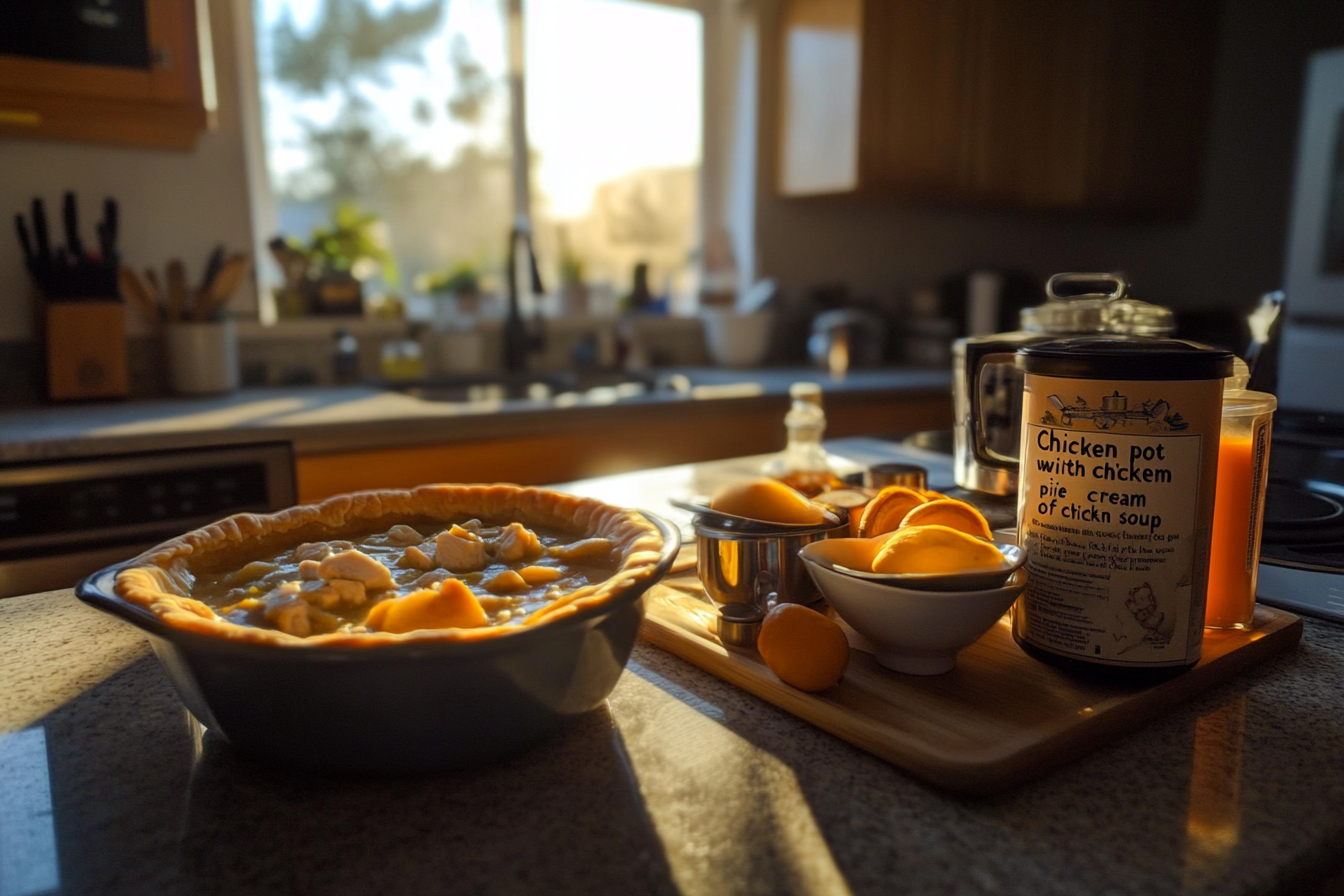Introduction to Chicken Pot Pie
Chicken pot pie is the epitome of comfort food—a warm, creamy filling enveloped in a golden, flaky crust. Its versatility and nostalgic appeal make it a favorite for family dinners and potlucks alike. This version, featuring cream of chicken soup, simplifies the process without sacrificing flavor, making it ideal for busy cooks and beginners.
In this guide, we’ll explore how to create a delicious chicken pot pie using simple ingredients, step-by-step instructions, and plenty of customization options to suit your taste and dietary needs.
Why Use Cream of Chicken Soup for Pot Pie
Using cream of chicken soup in your pot pie is a time-saving hack that guarantees a creamy, well-seasoned filling every time. Here’s why it’s a game-changer:
- Convenience: Eliminates the need for making a roux or béchamel from scratch.
- Consistency: Provides a rich, velvety texture that binds the filling perfectly.
- Flavor Boost: Comes pre-seasoned, so it complements the chicken and vegetables beautifully.
Whether you use a store-bought can or whip up a homemade version, cream of chicken soup is the foundation for a comforting and cohesive pot pie.
Key Ingredients for the Recipe
Store-Bought or Homemade Cream of Chicken Soup
- Store-bought: Ready-to-use and widely available, ideal for quick meals.
- Homemade: Customize your soup with low-sodium broth, fresh cream, and your preferred seasonings for a healthier alternative.
Pre-Cooked or Rotisserie Chicken
- Save time by using shredded rotisserie chicken or leftover roasted chicken.
- Dice or shred the meat into bite-sized pieces for even distribution in the filling.
Vegetables: Frozen, Fresh, or Canned
- Frozen: Convenient and pre-chopped, options like peas, carrots, and green beans work well.
- Fresh: Dice fresh vegetables such as celery, onions, and mushrooms for added texture.
- Canned: Drain canned vegetables like corn or potatoes to prevent excess liquid in the filling.
Pie Crust or Biscuits for the Topping
- Pie crust: Provides a classic, flaky finish.
- Biscuits: Add a rustic, hearty touch.
- Puff pastry: Delivers a buttery, golden crust with extra layers.
Kitchen Tools and Equipment
Pie Dish or Baking Pan
Choose a 9-inch pie dish or a similar-sized baking pan with high sides to hold the filling securely.
Mixing Bowls and Measuring Tools
Ensure consistent results by using mixing bowls for combining ingredients and measuring tools for
Step-by-Step Instructions for Chicken Pot Pie with Cream of Chicken Soup
Preparing the Ingredients
Getting everything ready before you start cooking is key to a smooth preparation process. Here’s how to prep your ingredients effectively:
Shredding or Dicing Pre-Cooked Chicken
- Use rotisserie chicken or any pre-cooked chicken.
- Remove the skin if you prefer a leaner dish, and shred the meat using two forks or chop it into bite-sized pieces.
- Aim for about 2-3 cups of chicken, depending on the size of your pie.
Prepping Vegetables: Dicing Fresh or Defrosting Frozen
- Fresh vegetables: Wash and dice them into small, uniform pieces to ensure even cooking. Popular options include:
- Carrots
- Celery
- Onions
- Mushrooms
- Frozen vegetables: Let them thaw slightly and drain off any excess water to avoid a watery filling.
- Canned vegetables: Drain thoroughly to maintain the right consistency.
Mixing Cream of Chicken Soup with Seasonings
- Combine one can (about 10.5 ounces) of cream of chicken soup with:
- 1/2 cup of milk, cream, or chicken broth to thin the mixture.
- Optional spices like garlic powder, onion powder, thyme, or paprika for added depth of flavor.
- Whisk until smooth and lump-free.
Making the Filling
Combining Chicken, Vegetables, and Cream of Chicken Soup
- In a large mixing bowl, combine the shredded chicken, vegetables, and soup mixture.
- Stir gently to ensure everything is evenly coated with the creamy sauce.
Adjusting Consistency with Milk, Broth, or Water
- If the mixture feels too thick, add a splash of milk, chicken broth, or water, one tablespoon at a time.
- The ideal consistency should be creamy but not runny, as this prevents the filling from spilling over during baking.
Seasoning with Salt, Pepper, and Optional Herbs
- Taste the filling and adjust the seasoning:
- Add salt and black pepper to taste.
- Sprinkle in fresh or dried herbs such as parsley, thyme, or rosemary for extra flavor.
Assembling the Pot Pie
Lining the Pie Dish with a Bottom Crust (Optional)
- If you’re using a double-crust setup:
- Roll out the bottom crust and lay it into the greased pie dish.
- Press it gently against the sides, trimming any excess dough from the edges.
- Use a fork to poke a few holes in the crust to prevent air bubbles during baking.
Pouring the Filling into the Dish
- Transfer the prepared filling into the pie dish, spreading it evenly to ensure uniform cooking.
- Leave about 1/2 inch of space from the top to prevent overflow.
Adding the Top Crust, Biscuits, or Puff Pastry
- For a pie crust:
- Roll out the top crust and lay it over the filling.
- Crimp the edges with your fingers or a fork to seal.
- Cut small slits in the top to allow steam to escape.
- For biscuits:
- Arrange uncooked biscuit dough evenly over the filling.
- Leave slight gaps between them to allow for expansion as they bake.
- For puff pastry:
- Lay a sheet of puff pastry over the dish, tucking the edges inside the pan for a clean finish.
Baking the Pot Pie
Preheating the Oven for Even Cooking
- Preheat your oven to 375°F (190°C) to ensure the crust cooks evenly without burning.
Baking Time and Temperature
- Place the assembled pot pie in the oven and bake for 30-40 minutes.
- Check for doneness by ensuring:
- The crust is golden brown.
- The filling is bubbling slightly around the edges.
Checking for Golden-Brown Crust
- After 25 minutes, keep an eye on the crust. If it’s browning too quickly, cover the edges with aluminum foil to prevent burning.
Allow the pot pie to cool for 5-10 minutes before serving. This resting period helps the filling set and makes slicing easier.
Variations and Customizations for Chicken Pot Pie with Cream of Chicken Soup
Alternative Toppings
The beauty of chicken pot pie lies in its adaptability. While the traditional pie crust is a favorite, experimenting with alternative toppings can elevate your dish to new heights.
Puff Pastry for a Flaky Crust
- Use puff pastry for a buttery, flaky crust with extra texture.
- Roll the pastry slightly thinner to cover the dish, then tuck the edges into the pan.
- Brush the surface with an egg wash for a glossy, golden finish.
Biscuits for a Rustic Finish
- Arrange raw biscuit dough on top of the filling.
- Space them evenly, leaving small gaps to allow the filling to bubble up as it bakes.
- Use canned, homemade, or frozen biscuits for convenience.
Mashed Potato Topping for a Twist
- Swap the crust entirely for creamy mashed potatoes.
- Spread the mashed potatoes evenly over the filling, using a fork to create decorative peaks.
- Sprinkle with shredded cheese or breadcrumbs for an extra layer of flavor and texture.
Additional Filling Ingredients
Take your chicken pot pie to the next level by incorporating extra ingredients that enhance flavor and texture.
Adding Cheese for a Creamier Flavor
- Mix shredded cheese such as cheddar, mozzarella, or Gruyère into the filling.
- Sprinkle a layer of cheese between the filling and the crust for a gooey surprise.
Using Different Proteins: Turkey or Ham
- Substitute chicken with diced turkey or ham for a unique twist.
- This is an excellent way to repurpose holiday leftovers, especially after Thanksgiving or Christmas.
Including Extra Vegetables like Mushrooms or Zucchini
- Sauté sliced mushrooms, diced zucchini, or bell peppers for a colorful and nutrient-rich filling.
- Add spinach or kale for a boost of leafy greens.
Dietary Modifications
Chicken pot pie can be adjusted to fit various dietary preferences or restrictions without compromising on flavor.
Gluten-Free Crust and Soup Options
- Use a gluten-free pie crust or biscuit mix, available at most grocery stores.
- For the filling, substitute regular cream of chicken soup with a gluten-free variety or make your own using gluten-free flour as a thickener.
Dairy-Free Substitutions for Cream of Chicken Soup
- Replace cream of chicken soup with a dairy-free alternative made from coconut milk, almond milk, or cashew cream.
- Use olive oil or plant-based butter to sauté vegetables or create a roux.
Lower-Calorie Adjustments
- Use low-fat cream of chicken soup and skim milk to reduce calorie content.
- Opt for leaner proteins like chicken breast and load up on vegetables to bulk up the filling.
Serving, Storage, and Reheating Tips
Serving Suggestions
Pair your chicken pot pie with complementary sides and garnishes for a complete, satisfying meal.
Pairing with Side Dishes like Salad or Bread
- Serve with a crisp green salad dressed in a tangy vinaigrette to balance the richness of the pie.
- Offer warm, crusty bread or dinner rolls to soak up the creamy filling.
Garnishing with Fresh Herbs or Cheese
- Sprinkle chopped fresh parsley, thyme, or rosemary over the baked pot pie for a burst of freshness.
- Add a light dusting of grated Parmesan cheese for an extra savory touch.
Storing Leftover Pot Pie
Proper storage ensures your leftover chicken pot pie stays fresh and flavorful.
Refrigeration for Short-Term Storage
- Allow the pot pie to cool completely before covering it with plastic wrap or transferring it to an airtight container.
- Store in the refrigerator for up to 3 days.
Freezing for Long-Term Storage
- Portion the pot pie into individual servings for easier reheating.
- Wrap tightly in aluminum foil or place in freezer-safe containers.
- Freeze for up to 3 months for best quality.
Reheating for Best Results
Reheating your pot pie properly ensures the crust stays crispy and the filling warms evenly.
Using the Oven to Retain Crispness
- Preheat your oven to 350°F (175°C).
- Place the pot pie on a baking sheet and cover loosely with aluminum foil to prevent over-browning.
- Heat for 20-30 minutes, or until the filling is hot and bubbling.
Microwave for Quick Reheating
- Transfer a portion of the pot pie to a microwave-safe dish.
- Cover with a microwave-safe lid or damp paper towel to retain moisture.
- Heat in 30-second intervals, stirring the filling as needed to ensure even warming.
Common Mistakes and How to Avoid Them
Preventing a Soggy Crust
- Pre-bake the bottom crust for 5-7 minutes before adding the filling.
- Brush the crust with a thin layer of egg white or melted butter to create a moisture barrier.
Achieving the Right Filling Consistency
- Avoid a runny filling by mixing a tablespoon of cornstarch or flour into the soup mixture if needed.
- For overly thick filling, add a splash of milk or broth until the consistency is creamy but not watery.
Avoiding Overcooking the Topping
- Monitor the crust closely in the final minutes of baking.
- If it begins to brown too quickly, cover the edges with foil to protect them from burning.
Learn More :

